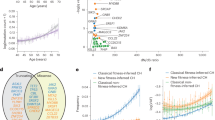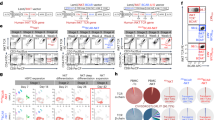Abstract
Information regarding the chimeric status of hematopoietic stem cell transplantation (HSCT) recipients is of great significance when comparing different conditioning and prophylactic therapies. In recent years, short tandem repeats/variable number tandem repeats (STRs/VNTRs) have emerged as the best tool for chimerism monitoring. However, the polymorphisms of STR/VNTR markers vary within and between ethnic groups. The issue is further complicated in a heterogeneous population such as occurs in the Indian subcontinent. In the present study, we attempted to devise a robust scheme to identify a set of polymorphic STRs/VNTRs most suitable for chimerism evaluation in north Indian HCST recipients. At first, we did genotyping of 11 STR and one VNTR in 1000 randomly chosen north Indian individuals to quantify different diversity parameters. Resulting data indicated that ApoB3′HVR, FES, VWA, D3S1358 and D16S310 were most polymorphic loci with the average heterozygosity being 0.756±0.17. Furthermore, all markers were genotyped in 77 HLA-matched donor–recipient pairs to evaluate the informativeness in differentiating donor's and recipient's cells. A panel of seven markers (ApoB3HVR-D3S1358-HUM-THO1-VWF-1-D16S310-FES-VWA) differentiated 98.70% of donor–recipient pairs. This set of markers also successfully monitored the graft status in 14 HSCT cases during multiple time points following HSCT. The results were compared to the commercially available AmpF/STR SGM Plus multiplex PCR kit (Applied Biosystems, Foster City, CA, USA). Our findings established that the panel of seven markers we identified was more cost-effective and informative.
This is a preview of subscription content, access via your institution
Access options
Subscribe to this journal
Receive 12 print issues and online access
$259.00 per year
only $21.58 per issue
Buy this article
- Purchase on Springer Link
- Instant access to full article PDF
Prices may be subject to local taxes which are calculated during checkout

Similar content being viewed by others
References
Cavalli-Sforza LL, Feldman MW . The application of molecular genetic approaches to the study of human evolution. Nat Genet 2003; 33 (Suppl): 266–275.
Fischer A, Wiebe V, Paabo S, Przeworski M . Evidence for a complex demographic history of chimpanzees. Mol Biol Evol 2004; 21: 799–808.
Jorde LB, Wooding SP . Genetic variation, classification and ‘race’. Nat Genet 2004; 36: S28–S33.
Khan F, Phadke S, Nityanand S, Talwar S, Agrawal S . Use of ApoB′ hyper variable region in studying mixed chimerism and maternal contamination in North Indian populations. J Clin Forensic Med 2004; 11: 183–188.
Slavin S, Nagler A, Kapelushnik Y, Aker M, Cividalli G, Varadi G et al. Nonmyeloablative stem cell transplantation and cell therapy as an alternative to conventional bone marrow transplantation with lethal cytoreduction for the treatment of malignant and nonmalignant hematologic diseases. Blood 1998; 91: 756–763.
Khan F, Agarwal A, Agrawal S . Significance of chimerism in hematopoietic stem cell transplantation: new variations on an old theme. Bone Marrow Transplant 2004; 34: 1–12.
Schaap N, Schattenberg A, Bar B, Mensink E, de Man A, Geurts van Kessel A et al. Red blood cell phenotyping is a sensitive technique for monitoring chronic myeloid leukaemia patients after T-cell-depleted bone marrow transplantation and after donor leucocyte infusion. Br J Haematol 2000; 108: 116–125.
Roy DC, Tantravahi R, Murray C, Dear K, Gorgone B, Anderson KC et al. Natural history of mixed chimerism after bone marrow transplantation with CD6-depleted allogeneic marrow: a stable equilibrium. Blood 1990; 75: 296–304.
Seong CM, Giralt S, Kantarjian H, Xu J, Swantkowski J, Hayes K et al. Early detection of relapse by hypermetaphase fluorescence in situ hybridization after allogeneic bone marrow transplantation for chronic myeloid leukemia. J Clin Oncol 2000; 18: 1831–1836.
Alizadeh M, Bernard M, Danic B, Dauriac C, Birebent B, Lapart C et al. Quantitative assessment of hematopoietic chimerism after bone marrow transplantation by real-time quantitative polymerase chain reaction. Blood 2002; 99: 4618–4625.
Sellathamby S, Balasubramanian P, Sivalingam S, Shaji RV, Mathews V, George B et al. Developing an algorithm of informative markers for evaluation of chimerism after allogeneic bone marrow transplantation. Bone Marrow Transplant 2006; 37: 751–755.
Coomey CT, Koons BW, Presley KW, Smerick JB, Sobieralski CA, Stanley DM . DNA extraction strategies for amplified fragment length polymorphism analysis. J Forensic Sci 1994; 39: 1254–1269.
Perez-lezaun A, Calafell F, Mateu E, Comas D, Bosch E, Bertranpetit J . Allele frequency for 20 microsatellites in a worldwide population survey. Hum Hered 1997; 47: 189–196.
Childs R, Clave E, Contentin N, Jayasekera D, Hensel N, Leitman S et al. Engraftment kinetics after nonmyeloablative allogeneic peripheral blood stem cell transplantation: full donor T-cell chimerism precedes alloimmune responses. Blood 1999; 94: 3234–3241.
Frossard PM, Lestringant GG . Analysis of an apolipoprotein B gene 3′ hypervariable region among Abhu Dhabi emirates. Ann Saudi Med 2001; 19: 490–494.
Rosenberg NA, Pritchard JK, Weber JL, Cann HM, Kidd KK, Zhivotovsky LA et al. Genetic structure of human populations. Science 2002; 298: 2381–2385.
Agrawal S, Muller B, Bharadwaj U, Bhatnagar S, Sharma A, Khan F et al. Microsatellite variation at 24 STR loci in three endogamous groups of Uttar Pradesh, India. Hum Biol 2003; 75: 97–104.
Das B, Chauhan PS, Sheshadri MS . Genetic polymorphism study at four minisatellite loci (D1S80, D17S5, D19S20 and APOB) among five Indian population groups. Hum Biol 2002; 74: 345–361.
Thiede C, Bornhauser M, Ehninger G . Evaluation of STR informativity for chimerism testing--comparative analysis of 27 STR systems in 203 matched related donor–recipient pairs. Leukemia 2004; 18: 248–254.
Hassan R, Bonamino MH, Braggio E, Lobo AM, Seuanez HN, Tabak DG et al. A systematic approach to molecular quantitative determination of mixed chimerism following allogeneic bone marrow transplantation: an analysis of its applicability in a group of patients with severe aplastic anaemia. Eur J Haematol 2004; 73: 156–161.
Acknowledgements
We thank Indian Council of Medical Research (ICMR) New Delhi and the Sanjay Gandhi Post Graduate Institute of Medical Sciences Lucknow for providing various lab facilities and for other assistance. We appreciate the assistance of Dr Catherine Ivory in carrying out the linguistic modifications of the manuscript.
Author information
Authors and Affiliations
Corresponding author
Rights and permissions
About this article
Cite this article
Talwar, S., Khan, F., Nityanand, S. et al. Chimerism monitoring following allogeneic hematopoietic stem cell transplantation. Bone Marrow Transplant 39, 529–535 (2007). https://doi.org/10.1038/sj.bmt.1705626
Received:
Revised:
Accepted:
Published:
Issue Date:
DOI: https://doi.org/10.1038/sj.bmt.1705626
Keywords
This article is cited by
-
Successful allogeneic hematopoietic stem cell transplantation with reduced-intensity conditioning for B-cell prolymphocytic leukemia in partial remission
International Journal of Hematology (2014)



